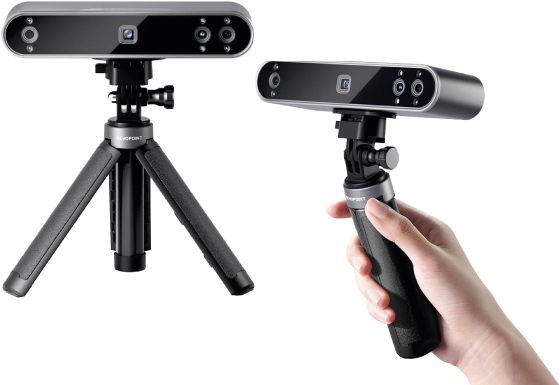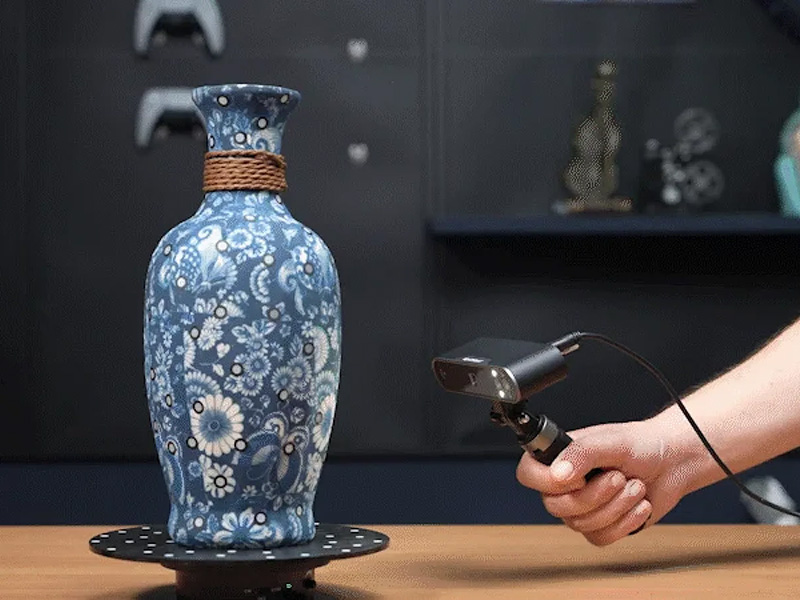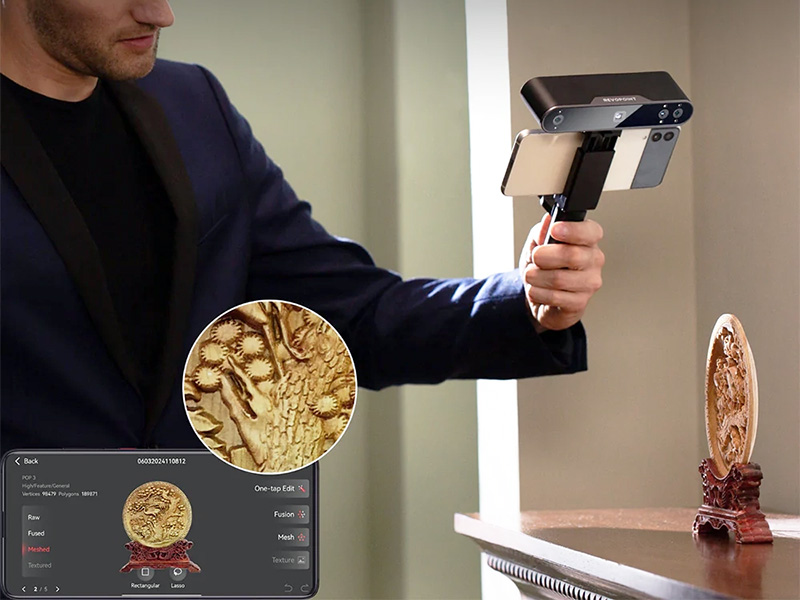POP 3 Plus
- 2-in-1 Device – can be used as both a handheld and a desktop scanner
- High Accuracy – maximum single-frame accuracy up to 0.08 mm, point distance ranging from 0.05–3 mm
- Smooth Scanning at speeds up to 18 frames per second
- Dual HD RGB camera with extended aperture delivers more accurate colors and finer textures
- New Global Marker Mode and Flash LED Lighting System for better marker visibility and improved point cloud alignment
- 9-Axis IMU eliminates defective frames caused by fast movements or vibrations


Accurate and True-to-Life Color Scans
Become a professional in 3D modeling and start creating reliable 3D scans with maximum single-frame accuracy up to 0.08 mm and high smooth scanning speed of up to 18 frames per second. This high accuracy allows capturing even the smallest details, opening the door to a wide range of applications – from educational projects and digital archiving to 3D printing design.
Create vivid, realistic, full-color 3D scans with 20% higher accuracy and precision than previous generations using the enhanced HD RGB camera. The wider aperture allows more light to reach the sensor, resulting in more realistic colors and finer textures. The maximum frame size reaches 244 × 180 mm and in combination with the Flash LED lighting system significantly improves marker and detail visibility while eliminating unwanted shadows, leading to smoother and hassle-free scanning of even complex objects.
Precision in Every Move
Enjoy advanced scanning and frame alignment functions thanks to the 9-axis IMU (Inertial Measurement Unit) and sophisticated algorithms, which effectively eliminate errors caused by fast movements or device vibrations. This ensures smooth and accurate operation without the need for repeated attempts.

Powerful Mobile Scanning
Three-touch button control allows easy start/pause of scanning and simple adjustment of the dual camera exposure. Two LED lights provide better visual feedback.
The lightweight and compact design of the POP 3 Plus scanner, combined with mobile device compatibility, makes it a powerful tool for flexible on-the-go scanning.
With Wi-Fi 6 technology, the POP 3 Plus can transfer data nearly three times faster.
In the Advanced Edition, the scanner comes with a case that also fits all accessories. The Advanced Edition includes a range of accessories including a rotating scanning base, power bank, and handheld stabilizer.
Technical Specifications
Scanning Performance
| Accuracy: | 0.08 mm |
| Resolution: | ±0.1 mm |
| Frame Rate: | up to 18 frames per second |
| Tracking Mode: | tracking, markers, Global Marker mode |
| Working Distance: | 150–400 mm |
| Point Distance: | up to 0.05 mm |
| Single Scan Range at Closest Distance: | 61 × 68 mm at 150 mm |
| Single Scan Range at Farthest Distance: | 244 × 180 mm at 400 mm |
| Minimum Object Size: | 20 × 20 × 20 mm |
| Maximum Object Size: | 2 × 2 × 2 m |
Hardware Specifications
| Technology: | dual camera; Class 1 IR laser (eye-safe) |
| Auxiliary Lighting: | infrared fill lights, white Flash LED |
| Field of View: | 40 × 25° |
| CPU: | 2-core, 1.6 GHz |
| Position Sensors: | 9-axis IMU |
| Connectivity: | USB Type-C |
| Dimensions: | 153 × 45 × 29 mm |
| Weight: | 190 g |
Software System Requirements
| Supported Export Formats: | PLY, OBJ, STL, ASC, 3MF, GLTF, FBX |
| Operating Systems: | Windows 10/11 (64-bit), Android, iOS, macOS 11.0 or higher |
| Recommended Computer Requirements: |
macOS: CPU: M3 or better; RAM ≥ 8GB Windows: CPU: Intel i9 11th Gen or better; RAM ≥ 32GB |
3D Scanning: A Modern Way to Connect Reality and Digital Creation
3D scanning is becoming an integral part of modern education as it offers a unique way to bridge the real world with digital technologies. Using 3D scanners such as the Revopoint POP 3 Plus, students can easily capture accurate three-dimensional models of real objects – whether historical artifacts, natural specimens, or technical components. These digital copies then serve as a starting point for further processing and creative activities.
3D scanning technology allows students to examine object shapes, textures, and proportions in detail, enhancing spatial imagination and technical thinking. They can, for example, study anatomy or complex mechanisms in ways that would otherwise require expensive or hard-to-access tools.
In addition, 3D scanning enables practical work with digital models – editing, simulations, or preparation for 3D printing. This process supports not only creativity but also the development of digital skills, which are essential for future careers in fields such as engineering, design, or medicine.
Thanks to its ease of use and increasingly affordable price, 3D scanners are becoming an ideal tool for schools looking to enhance their STEAM programs and give students the opportunity to work with cutting-edge technologies.
